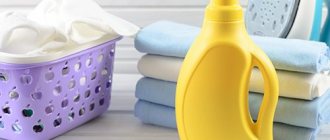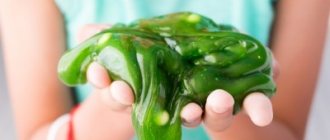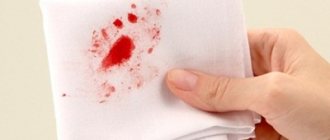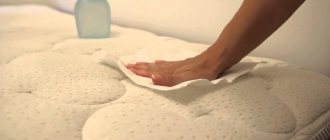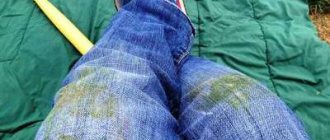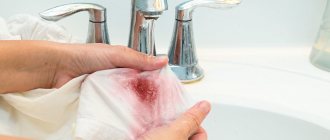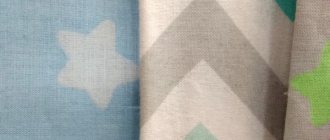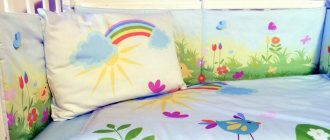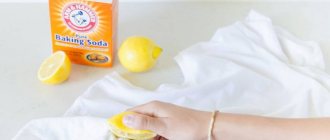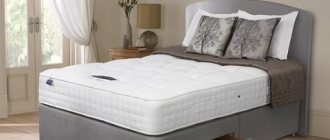Long-term storage in a closet, violation of washing and ironing rules are an incomplete list of reasons why unattractive yellow spots and stains may appear on white clothes.
Why do yellow spots appear on white things after washing? How can I remove iron stains?
Knowing the secrets of how to get rid of yellowness will help restore your favorite item to its original appearance.
Store-bought bleaches: which one to buy
To make the right choice, you need to study the range offered by manufacturers and the mechanism of action of various products.
- Chlorine. As a result of a chemical reaction of the active component (sodium hydrochloride), active oxygen is released, which is a bleaching agent.
- Optic. Contains luminescent dyes that create an optical illusion: the laundry looks snow-white, but in fact it is not.
- Oxygen. As a result of a chemical reaction of the active component (hydrogen peroxide, potassium peroxosulfate, sodium or potassium peroxocarbonate), active oxygen is released, which, being a powerful oxidizing agent, eliminates contaminants.
The pros and cons of different types of bleaches are described in the table below.
Table - Advantages and disadvantages of professional bleaches
| Bleach type | Behind | Against |
| Chloric (White, Ace) | - Affordable price; — high-quality disinfection; - whitens even in cold water | — Damages the fabric, reduces strength; — not suitable for automatic washing; — caustic fumes can cause irritation and poisoning; — used only when washing items made of cotton and linen, not suitable for delicate fabrics and synthetics |
| Optical (“OV-1”) | — Possibility of achieving the effect of dazzling whiteness | - Works only on clean things; — does not remove stains and stains; - does not rinse out of fabric |
| Oxygen (“ecO2”, “Selena”, “Persol”, Extra, Shabondama) | — Delicate removal of contaminants; — possibility of use at low water temperatures; — helps to whiten laundry at home effectively; - completely rinses out of the fabric; — provides good disinfection; - can be mixed with powder when machine washed | - High price |
How to use
When buying bleach, it is better to give preference to products without chlorine. When using oxygen fabric bleach or optical bleach, it is recommended to strictly follow the instructions on the package, since the dosage and method of application for hand and machine washing may differ.
Often housewives “the old fashioned way” use the most affordable chlorine bleach - whiteness, considering this product to be effective and the best. However, you need to remember that frequent use of bleach can have a bad effect on the condition of the fabric and you should only use it when hand washing cotton and linen items. To bleach things white, be sure to wear rubber gloves and follow these four steps.
- Stir 100-200 g of grated brown soap (72%) into 10 liters of warm water.
- Add white to the composition (a tablespoon per 3 liters of solution).
- Leave the laundry in the prepared product for 15-20 minutes.
- Rinse thoroughly in clean water.
Fighting hyperhidrosis
Now science has moved forward, and sweat stains can be prevented.
For this purpose, special antiperspirants were invented. For example, these include personal hygiene products Maxim, ODABAN, etc. Regardless of lifestyle, weather conditions, etc., sweat does not appear on clothes and body at all. There is no unpleasant odor either. Armpits always remain dry. These same brands also offer deodorants for the body, feet and hands. These products are used once a week (rarely twice) after a shower before bed. The exception is cases when the deodorant does not have the desired result due to the individual characteristics of the body.
The price of this kind of antiperspirants is ten times higher than the cost of conventional deodorants and can reach $25.
“Grandmother’s” advice: boiling...
Despite the abundance of special products on store shelves, “grandmother’s” methods of whitening clothes do not lose their relevance. Folk remedies are a real salvation for housewives who care not only about the cleanliness of the house, but also about the safety of the family budget. The most popular option is boiling. But it is permissible to resort to this method only when bleaching cotton and linen products: these fabrics are not afraid of high temperatures.
Before boiling, it is necessary to prepare a basic cleaning solution. The recipe is as follows: dissolve 0.5-1 cups of washing powder or 100-30 g of 72% brown soap pre-ground on a coarse grater in 10 liters of warm water. Boiling in a solution of laundry soap is more environmentally friendly. This method is recommended for children's sleeping sets.
Classic version
- Cover the bottom of a large galvanized or enameled container with a piece of white cloth or a towel.
- “Load” bed linen into the container, having first thoroughly soaped any existing stains.
- Pour in the previously prepared cleaning solution.
- Bring the mixture to a boil and let the laundry simmer over low heat for half an hour to an hour.
- Stir the products from time to time with a wooden stick or special tongs.
You should not use dishes made of copper and iron for boiling: such materials can oxidize and stain the material when heated.
"Advanced" option
To make boiling bleaching more effective, additional components can be added to the detergent composition.
- Ammonia. A tablespoon of the product is immediately mixed into the cleaning solution.
- Bleaching powder. Pour an equal amount of water into a teaspoon of lime and mix. Dissolve the resulting slurry in a liter of water and let the mixture settle: it should become completely transparent. Add the finished product to the bed linen boiling in the washing solution and, stirring constantly, let it simmer for half an hour. When used frequently, bleach significantly degrades the quality of the material.
- Soda ash or baking soda. Soak the laundry in a boiling soap solution for half an hour with the addition of three to four tablespoons of soda.
- Soda, turpentine, brown soap. Boil things for half an hour in a special composition: stir 50 g of soda, 70 g of turpentine and 100 g of crushed brown soap in 10 liters of water.
When using bleach, turpentine and ammonia, it is better to leave the kitchen, returning periodically to stir the laundry, as harmful fumes are released during the heating process.
How to remove sweat smell from clothes without washing
Not all items can be washed. A coat made of tweed, polyester or wool is cleaned of sweat as follows:
- The coat is turned inside out and hung on hangers.
- A vinegar solution is sprayed onto the smelly areas.
- Air your coat in the open air.
A good option for eliminating odor without washing is to wipe the areas under the sleeves with damp soda and 1-2 drops of tea tree essential oil. The soda will absorb sweat, and the oil will destroy bacteria in a matter of seconds.
... soaking
It is not always possible to resort to boiling bedding. The following may interfere with the implementation of this method:
- Lack of time;
- delicacy of fabric;
- lack of kitchen space or necessary equipment.
Therefore, for a modern housewife, the question of bleaching without boiling is relevant. In this case, long-term soaking in special compounds is suitable.
Soda
- In 10 liters of warm water, stir ten tablespoons of soda (baking or soda ash) and five tablespoons of ammonia solution.
- Load the kit into the composition.
- After three to four hours, wash the items (in a washing machine or by hand) and rinse vigorously.
Soda is considered one of the safest bleaches for fabrics. However, this product is difficult to deal with heavy stains. This method will help remove yellowness from bed linen, but in particularly advanced cases you will have to repeat the manipulation several times.
Solevoe
- Dissolve five to seven tablespoons of table salt in 10 liters of warm water.
- Leave the bed linen in the composition overnight.
- Wash items in the usual way.
Combined
- Mix two tablespoons of ammonia and washing powder in 10 liters of warm water.
- Add three tablespoons of peroxide (3%) and eight tablespoons of soda.
- Soak the laundry in the mixture for four to five hours.
- Wash items in the usual way, rinse.
Mustard
- Pour boiling water over mustard powder at the rate of one tablespoon per liter of liquid.
- After two hours, drain the water and use it to soak bed linen.
- Keep things in the composition for at least three to four hours.
- Wash items in the usual way.
This homemade bleach recipe is suitable for delicates and synthetic fabrics.
Video on the topic
Oily
- In 10 liters of hot, just boiling water, dilute two tablespoons of bleach and vegetable oil. (Regular sunflower oil will do).
- Add five tablespoons of washing powder.
- Immerse the laundry in the composition.
- Cover the container with a lid or plastic wrap.
- After ten hours, rinse the laundry in running water.
- Throw it into the machine.
In turpentine
- To make this fabric bleach at home, combine two tablespoons each of ammonia and turpentine.
- Pour the mixture of pharmaceutical drugs into 5 liters of water.
- Immerse machine-washed bedding in the solution for several hours.
- Rinse vigorously.
Manganese
- Boil 10 liters of water and immediately stir 100 g of laundry soap (72%) or a glass of washing powder into the liquid.
- In a separate small jar, dilute several crystals of potassium permanganate: the solution should turn out slightly pinkish.
- Pour potassium permanganate into the detergent composition.
- Immerse the laundry in the solution and cover the container with a lid or polyethylene.
- To enhance the effect, things can be pre-moistened and rubbed with laundry soap.
- After six or more hours, rinse the items and try to further wash the bed linen from grayness in the machine.
The use of potassium permanganate for bleaching laundry is best considered as a last resort. Firstly, today the drug is not available in pharmacies without a prescription, so if you don’t have a supply at home, getting it is problematic. Secondly, it is not always possible to dissolve crystals well; if an undissolved “point” comes into contact with a white sheet, it will be quite problematic to remove it.
Causes of stains on clothes under the arms
Sweating is an integral part of the normal functioning of our body, and is not always comfortable in everyday life. Stress, excess body weight, changes in hormonal levels, increased thyroid function, banal heat outside - all this can cause increased moisture secretion in the armpits.
In fact, the sweat of a healthy person is colorless and does not have a pronounced odor. Stains on fabric are mostly caused by dried stains. Yellow stains on white clothes and white stains on dark ones are the result of mixing antiperspirant/deodorant with secretions from the sweat glands. There is another reason, but not so harmless - chromohidrosis, a malfunction of the sweat glands, as a result of which the sweat acquires an unusual color, and therefore noticeably stains clothes.
Sweat plays a very important role in the body: it prevents overheating, removes toxins, cleanses pores and destroys viruses and bacteria in our body.
How to bleach white bed linen if you don't have time
The fast pace of modern life forces housewives to look for express methods of whitening bed linen. Such methods exist, but it is important to understand that they will not cope with severe contamination. The most basic option: add a couple of tablespoons of baking soda into the washing machine along with the powder. What else should I do? Try the method of whitening laundry with hydrogen peroxide. You should act in five stages.
- Load the kit into the machine.
- Combine a tablespoon of ammonia and two tablespoons of peroxide in 5 liters of water.
- Heat the solution over low heat to 70°C, but do not allow it to boil.
- Soak washed laundry in the prepared mixture.
- After 30-40 minutes, rinse the items thoroughly in clean water.
When using hydrogen peroxide, it is important to ensure that the laundry is completely immersed in the solution: yellow stains will appear on the uncovered areas after drying.
We return the whiteness to yellowed laundry
After many washes, light-colored fabric can acquire a gray, yellow, or light green tint. There are several reasons for this negative impact:
- Washing water with a high iron content (more than 7 degrees of hardness), nitrates.
- The use of washing powders, stain removers with a high content of phosphates, flatates, and hydrochloric acid.
- Regularly wash light-colored bed linen with dark-colored items.
Folk methods that use gentle detergents will help restore a presentable appearance to products. In addition to the loss of natural shine and color, stains of various origins appear on the fabric.
"Snow" rinses
A lifesaver that returns whiteness to laundry will be homemade rinse aids.
- With boric acid. Dilute boric acid in warm water (one or two tablespoons per 3 liters of liquid). Rinse the washed clothes in the composition for several minutes. After this, rinse thoroughly in clean water.
- With starch or baking powder. Stir two to four tablespoons of potato starch or baking powder into 10 liters of clean warm water. In the composition, rinse the laundry after washing. No additional rinsing in clean water is required.
After some bleaching methods, products acquire an unpleasant odor. To make the fabric smell fragrant, you can rinse the laundry in clean water, after dissolving a small amount of commercial fabric softener or two or three drops of your favorite essential oil.
I washed my clothes, but the smell of sweat remained - why?
Sweat itself is often odorless. An unpleasant odor is a consequence of the activity of bacteria that live on the skin. If the smell of sweat remains on things after washing, it means that microbes are still alive and multiplying in the weave of the threads. In this case, you need to use disinfection of yellowed areas on clothing , because that is where the bacteria are concentrated.
Simple tips will help you get rid of sweat quickly and without additional costs:
- Sweaty items are washed separately from other clothes.
- Before washing, they are pre-rinsed under running water.
- The amount of powder is increased if the clothes smell unpleasant.
- The last rinse cycle is best done with the addition of fabric softener.
- It is better to dry any clothes in the fresh air rather than indoors.
Clothes that smell of old sweat should not be worn. They are immediately put in the wash. Under no circumstances should you iron clothes soaked in sweat with an iron in the steam mode. This will drive the odor deeper into the fibers, making it more difficult to get rid of.
Natural fabrics absorb sweat faster, but wash well. Fabrics made from synthetic fibers absorb sweat worse, but it is more difficult to wash.
Precautionary measures
To combat products effectively and safely, you must follow a few simple rules:
- Always pay attention to the care rules and recommendations, which must be sewn to the tag on the inside of the item.
- Also follow the instructions for stain removers and bleaches.
- If you cannot determine the type of tissue, it is better not to take risks and use only a universal oxygen agent. Otherwise, removing the stain may lead to its final fixation on the fabric or removal of paint in the armpit area.
- It is prohibited to use chlorine-containing bleaches for any synthetics, too thin items made from natural fabrics, as well as natural silk..
- If the product is strongly rubbed during cleaning, the fabric may become thinner or the weave structure may be disrupted, which will lead to tears and holes.
- By constantly using chlorine-containing bleaches, we risk reducing the wear life of the product. After all, chlorine, penetrating deeply into the fibers, not only quickly bleaches them, but also quickly thins them.
Do not expose them to direct sunlight
Another reason why your pillows may change color to a more yellowish color is exposure to sunlight. This happens when they are exposed to sunlight for a long time.
Perhaps, above all, this is why your pillows are becoming more and more yellow and yellow?
The whole problem is that the chemicals used to bleach the pillows are, of course, snow-white. But given their specific nature, when they are exposed to direct sunlight, they begin to decompose and the color of your pillow begins to gradually change.
So remember not to expose your pillows and mattresses to unnecessary sunlight! Of course, this doesn't mean you can't ventilate them—in fact, you should do it as often as possible. However, try to place them in the shade or ventilate them during cloudy weather.
Preventing stains and odors
You can protect dresses, shirts and sweaters from stains by using special replaceable armpit pads. This is very convenient; you don’t have to wash dirty places every time. It is enough to change the pad for a new one, and we will solve the problem of sweating for the whole day.
These replacement inserts are very easy to use. You need to remove the protective film from the back and stick it to the clothes with the adhesive side. The pads perfectly absorb both sweat and odor. And they are completely invisible from the outside of clothing.
The inserts adhere well to clothing thanks to the adhesive base
Personal hygiene has not been canceled either. The more often you wash and treat your armpits, the less sweat will remain on your clothes. The person himself is more comfortable when he feels the freshness of his body.
If you sweat a lot, use an antiperspirant. The latter is fundamentally different from deodorant. If a deodorant simply removes the smell of sweat, leaving the moisture itself on the body, then an antiperspirant dries out the skin, and the salts in the product partially block sweating. Traces of antiperspirant will be dissolved by the same oxygen stain remover or crushed A spirin .
Deodorant and antiperspirant differ in their functions
Wear loose clothing. Fabric that is tight in the armpit is most likely causing sweating and also causing blemishes. Loose clothing will keep you cooler and reduce the chance of stains on your clothes.
